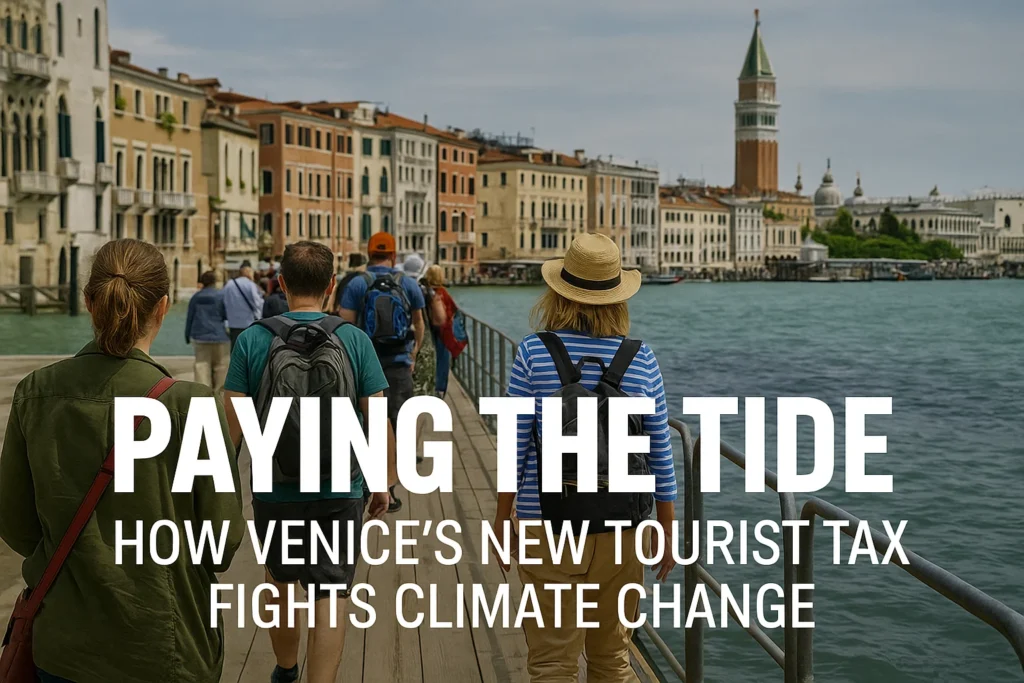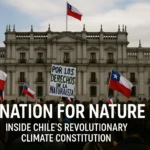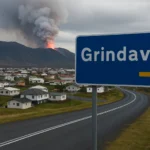The Watershed Moment That Changed Venice Forever
On the morning of November 13, 2019, Venetian glassmaker Giovanni Fabbri woke to find his centuries-old family workshop submerged under 1.5 meters of murky lagoon water. The previous night’s historic acqua alta had shattered display cases containing priceless Murano pieces, their vibrant colors now dulled by the Adriatic’s salty embrace. As Giovanni surveyed the damage, a group of German tourists waded past his open doorway, laughing as they recorded videos of themselves pretending to swim through the flooded calle.
“That was my breaking point,” Giovanni recalls, his calloused fingers tracing a waterline stain that still marks his workshop wall. “The floods were bad enough, but watching tourists treat our disaster like an amusement park? That’s when I joined the movement.”
Five years later, Venice has implemented what urban planners are calling the most radical tourism management system ever attempted by a world heritage city. The Dynamic Flood Tax represents not just a policy shift, but a fundamental reimagining of how fragile destinations might survive the dual threats of climate change and overtourism in the 21st century.
The Perfect Storm: Understanding Venice’s Existential Crisis
By the Numbers: A City Under Siege
Demographic Collapse:
- Resident population: 50,000 (down from 175,000 in 1951)
- Average age: 54 (youngest in mainland Mestre: 39)
- Vacant homes: 12,000 (mostly converted to tourist rentals)
Tourism Onslaught:
- Pre-pandemic visitors: 30 million annually
- Current levels: Stabilized at 25 million
- Cruise ship passengers (pre-ban): 1.6 million yearly
- Average stay: 1.2 nights (down from 3.5 nights in 1990)
Environmental Pressures:
- Annual flood days: 120 (up from 40 in 1970)
- Sea level rise: 30cm since 1900 (accelerating to 5mm/year)
- Building erosion: 3cm of stone loss per decade at waterline
- Lagoon pollution: 35 tons of daily waste from boats/tourists
The Four Horsemen of Venice’s Apocalypse
- Physical Subsidence
The city naturally sinks 1-2mm annually due to plate tectonics, compounded by groundwater extraction in the 20th century that accelerated the process. - Climate-Driven Sea Rise
Mediterranean levels are rising 30% faster than global averages due to regional wind patterns and ocean currents. - Wave Erosion
Before the cruise ship ban, wake from mega-liners generated waves equivalent to small tsunamis, destabilizing foundations. - Tourism Footprint
The weight of 30 million visitors annually causes measurable seismic activity and wears historic pavements at alarming rates.
Dr. Sofia Conti, lead oceanographer at Venice’s Institute of Marine Sciences, explains: “We’re not just fighting rising waters. The combination of mass tourism and climate extremes creates compound impacts that threaten the city’s very fabric.”
Inside the Dynamic Flood Tax: A Technological Masterpiece
The Algorithm That Could Save Venice
Developed through a partnership between Venetian data scientists and MIT’s Urban Risk Lab, the tax system represents a quantum leap in urban management:
Data Inputs:
- 78 tide gauges updating every 15 minutes
- 144-hour hydrodynamic forecasts from ISMAR-CNR
- AI crowd monitoring at 62 entry points
- Satellite subsidence measurements
- Cruise ship and vaporetto schedules
Machine Learning Components:
- Neural networks predicting tourist flows
- Bayesian models for flood risk assessment
- Reinforcement learning for price optimization
Blockchain Infrastructure:
- Immutable payment records
- Smart contracts for automatic fund allocation
- NFT-based access passes for residents
The Pricing Matrix (2024 Schedule)
| Threat Level | Tide Height | Weather | Crowd Density | Fee (€) |
|---|---|---|---|---|
| Green | <80cm | Clear | Low | 5 |
| Yellow | 81-110cm | Rain | Moderate | 10-15 |
| Orange | 111-140cm | Storm | High | 25-35 |
| Red | 141cm+ | Extreme | Critical | 50+ |
Real-World Example:
On March 12, 2024, the system automatically escalated fees from €5 to €38 as:
- Tide forecasts predicted 135cm flood
- Three cruise ships unexpectedly docked
- Rain saturated the drainage system
Enforcement Network: The Invisible Barrier
- Biometric Checkpoints
- 42 facial recognition gates at major entry points
- Palm vein scanners for frequent visitors
- Iris recognition being tested at Marco Polo Airport
- Mobile Enforcement
- AI-powered drones scanning water taxi passengers
- Underwater license plate readers for private boats
- Decoy “tourists” with hidden scanning devices
- Digital Verification
- Blockchain-based QR codes
- Cryptocurrency payment options
- Smartwatch geofencing
The Money Trail: Following the Millions
2024 Revenue Allocation (€58 million projected)
Flood Defense (40%)
- MOSE barrier maintenance: €9.2M
- Historic building waterproofing: €7.5M
- Wave energy dissipators: €4.3M
Resident Support (30%)
- Property tax relief: €8.7M
- Flood insurance subsidies: €5.2M
- Youth housing grants: €3.9M
Sustainable Tourism (20%)
- Electric vaporetto fleet: €6.8M
- Lagoon cleanup drones: €3.2M
- Responsible tourism campaigns: €1.8M
Innovation Fund (10%)
- Algae-based erosion control: €2.9M
- Augmented reality tours: €1.7M
- Salinity-resistant masonry: €1.2M
Success Stories
- The Subsiding School
San Marco Elementary received €420,000 for hydraulic jacks that automatically adjust the building’s height with tidal fluctuations. - Gondola 2.0
Traditional boatyards secured €1.3 million to develop hybrid-electric gondolas that reduce wake erosion. - AI Lifeguards
Lido beaches now deploy drone systems that predict rip currents 20 minutes before they form.
Global Ripple Effects: Which Cities Are Watching?
European Adopters
Barcelona
- Piloting “congestion pricing” for tourist zones
- Developed similar (but simpler) tax algorithm
- Facing fierce opposition from cruise industry
Amsterdam
- Implementing canal-level pricing tiers
- Testing “crowd heat maps” to disperse visitors
- Struggling with enforcement loopholes
Dubrovnik
- Adopted Venetian QR code system
- Seeing 18% reduction in peak-season day-trippers
- Planning underwater barriers inspired by MOSE
Beyond Europe
Maldives
- “Green Tax” now includes climate risk premium
- Investing in floating architecture R&D
- Luxury resorts funding coral regeneration
Kyoto
- Temple preservation surcharge
- AI predicting cherry blossom crowd patterns
- Traditional inns receiving tax breaks
Galapagos
- Dynamic pricing based on ecosystem stress
- Facial recognition at conservation sites
- 95% of fees funding scientific research
The Human Mosaic: Venetians Speak Out
The Young Activist
“Finally, tourists pay their fair share,” says 22-year-old university student Lucia Zorzi, founder of Venezia Autentica. “But we need to cap total visitors like Machu Picchu does.”
The Veteran Gondolier
Enrico Dandolo, 68, whose family has operated gondolas since 1793: “The tax helps, but we’re still losing 10 buildings a year to the sea. My grandson won’t have a city to inherit.”
The Reluctant Hotelier
Giovanna Marcello, owner of a 12-room pensione: “Occupancy dropped 30% since implementation. We’re surviving only because the tax revenue lowered our property taxes.”
The Controversy: Ethical Quandaries and Legal Battles
Discrimination Lawsuits
- EU Court of Justice reviewing claims the tax unfairly impacts:
- Budget travelers
- Disabled visitors
- Non-European tourists
Privacy Concerns
- Italian data authority investigating:
- Biometric data retention
- AI profiling accuracy
- Facial recognition false positives
Implementation Challenges
- False alarms: Overcharging during false flood predictions
- Black markets: Counterfeit QR codes selling for €20
- Enforcement gaps: Only 73% collection rate at water taxis
The Philosophical Divide
As Mayor Luigi Brugnaro frames it: “We must choose between being a living city or a Disneyland for Instagram. There is no third option.”
The Road Ahead: Venice 2030 and Beyond
Phase Two Rollout (2025-2027)
- Carbon Surcharge: €10-50 added to flights based on emissions
- Loyalty Program: Discounts for visitors funding restoration
- Dynamic Pricing 2.0: Incorporating air quality and waste metrics
Long-Term Projections
UNESCO climate models suggest:
- With current measures: 68% chance of viability through 2100
- Without intervention: 12% chance by 2075
- Optimal scenario: Could reduce flood damage by €220M/year
Existential Questions
- When does preservation become fossilization?
- Can technology outpace rising seas?
- What does “authentic Venice” even mean anymore?
The Bottom Line: A City Worth Saving?
As twilight paints the Rialto Bridge gold, an unusual quiet settles over Venice. The day’s last tax-paying tourists have departed, leaving the calli to the gurgle of receding tides and the footsteps of residents heading home. In his restored workshop, Giovanni Fabbri examines a newly crafted goblet—its glass threaded with filaments from discarded fishing nets, its form inspired by wave patterns from the 2019 flood.
“Every Venetian lives with water in their bones,” he muses, holding the piece to the light. “This tax isn’t about money. It’s about making visitors understand that here, the sea isn’t scenery—it’s a character in our story. And like any important relationship, it requires respect, compromise, and sometimes, hard boundaries.”
The world watches as this floating masterpiece writes perhaps its most surprising chapter yet—not in marble or mosaic, but in algorithms and accountability. Venice’s experiment may well determine whether other climate-threatened treasures from Angkor Wat to the Statue of Liberty will need to follow suit. One thing is certain: the tide of history is turning, and Venice intends to ride the wave rather than be crushed by it.



